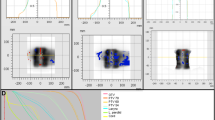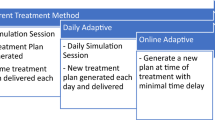Abstract
Inter-fractional anatomical variations in head and neck (H&N) cancer patients can lead to clinically significant dosimetric changes. Adaptive re-planning should thus commence to negate any potential over-dosage to organs-at-risk (OAR), as well as potential under-dosage to target lesions. The aim of this study is to explore the correlation between transit fluence, as measured at an electronic portal imaging device (EPID), and dose volume histogram (DVH) metrics to target and OAR structures in a simulated environment. Planning data of eight patients that have previously undergone adaptive radiotherapy for H&N cancer using volumetric modulated arc therapy (VMAT) at the Royal Adelaide Hospital were selected for this study. Through delivering the original treatment plan to both the planning and rescan CTs of these eight patients, predicted electronic portal images (EPIs) and DVH metrics corresponding to each data set were extracted using a novel RayStation script. A weighted projection mask was developed for target and OAR structures through considering the intra-angle overlap between fluence and structure contours projected onto the EPIs. The correlation between change in transit fluence and planning target volume (PTV) D98 and spinal cord D0.03cc with and without the weighting mask applied was investigated. PTV D98 was strongly correlated with mean fluence percentage difference both with and without the weighting mask applied (RMask = 0.69, RNo Mask = 0.79, N = 14, p < 0.05), where spinal cord D0.03cc exhibited a weak correlation (RMask = 0.35, RNo Mask = 0.53, N = 7, p > 0.05) however this result was not statistically significant. The simulation toolkit developed in this work provided a useful means to investigate the relationship between change in transit fluence and change in key dosimetric parameters for H&N cancer patients.







Similar content being viewed by others
Data availability
Not applicable.
Code availability
Not applicable.
Consent for publication
Not applicable.
References
Brouwer CL, Steenbakkers RJHM, Langendijk JA, Sijtsema NM (2015) Identifying patients who may benefit from adaptive radiotherapy: does the literature on anatomic and dosimetric changes in head and neck organs at risk during radiotherapy provide information to help? Radiother Oncol 115(3):285–294. https://doi.org/10.1016/j.radonc.2015.05.018
Castelli J et al (2015) Impact of head and neck cancer adaptive radiotherapy to spare the parotid glands and decrease the risk of xerostomia. Radiat Oncol. https://doi.org/10.1186/s13014-014-0318-z
Belshaw L, Agnew CE, Irvine DM, Rooney KP, McGarry CK (2019) Adaptive radiotherapy for head and neck cancer reduces the requirement for rescans during treatment due to spinal cord dose. Radiat Oncol. https://doi.org/10.1186/s13014-019-1400-3
van Elmpt W, McDermott L, Nijsten S, Wendling M, Lambin P, Mijnheer B (2008) A literature review of electronic portal imaging for radiotherapy dosimetry. Radiother Oncol 88(3):289–309. https://doi.org/10.1016/j.radonc.2008.07.008
Piron O, Varfalvy N, Archambault L (2015) MO-F-CAMPUS-J-05: using 2D relative gamma analysis from EPID image as a predictor of plan deterioration due to anatomical changes. Med Phys. https://doi.org/10.1118/1.4925466
Piron O, Varfalvy N, Archambault L (2016) EP-1818: using ROIs projected on EPID as a predictor of plan deterioration due to anatomical changes. Radiother Oncol 119(1):S852–S853
Piron O, Varfalvy N, Archambault L (2018) Establishing action threshold for change in patient anatomy using EPID gamma analysis and PTV coverage for head and neck radiotherapy treatment. Med Phys 45(8):3534–3545. https://doi.org/10.1002/mp.13045
Cilla S et al (2016) Initial clinical experience with EPID-based in vivo dosimetry for VMAT treatments of head-and-neck tumors. Phys Med 32(1):52–58. https://doi.org/10.1016/j.ejmp.2015.09.007
Lim SB et al (2019) Investigation of a novel decision support metric for head and neck adaptive radiation therapy using a real-time in vivo portal dosimetry system. Technol Cancer Res Treat. https://doi.org/10.1177/1533033819873629
You SH et al (2012) Is there a clinical benefit to adaptive planning during tomotherapy in patients with head and neck cancer at risk for xerostomia. Am J Clin Oncol. https://doi.org/10.1097/COC.0b013e31820dc092
Panchal A et al (2019) dicompyler/dicompyler-core v0.5.5. https://doi.org/10.5281/ZENODO.3236628
Funding
No funding was received for conducting this study.
Author information
Authors and Affiliations
Corresponding author
Ethics declarations
Conflict of interest
The authors have no relevant financial or non-financial interests to disclose.
Ethical approval
Approval was obtained from the Central Adelaide Local Health Network Human Research Ethics Committee (CALHN HREC). The procedures used in this study adhere to the tenets of the Declaration of Helsinki.
Informed consent
Each participant has given consent to participate, via the statement “I do approve the use of my radiation therapy records for retrospective medical auditing and/or research”.
Additional information
Publisher's Note
Springer Nature remains neutral with regard to jurisdictional claims in published maps and institutional affiliations.
Rights and permissions
About this article
Cite this article
Antoniou, G., Penfold, S.N. A novel TPS toolkit to assess correlation between transit fluence dosimetry and DVH metrics for adaptive head and neck radiotherapy. Phys Eng Sci Med 44, 1121–1130 (2021). https://doi.org/10.1007/s13246-021-01048-5
Received:
Accepted:
Published:
Issue Date:
DOI: https://doi.org/10.1007/s13246-021-01048-5




